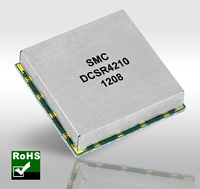Voltage-controlled oscillators (VCOs) are the tunable signal sources in a wide range of synthesizers, communications networks, test equipment, and other systems. The resonators in these sources can be formed in a variety of ways, including the use of high Q dielectric resonator (DR) materials. DR (Dielectric resonator) offers high Q factor and is well known for high spectral purity signal sources at microwave frequencies. The drawbacks are the DR based oscillators are costly, sensitive to vibration, microphonics, phase-hits sensitive, and also not suited for fabrication by current integrated circuit (IC) technology. The phase noise and DC-to-RF conversion efficiency are critical in setting the ultimate system performance limits of modern communication, radar and timing systems. Phase noise and higher order harmonics of a VCO are dependent on the DC power supply (DC operating condition), drive level (active device: BJTs/FETs) and the Q (Quality) factor of the components. The limitation on the DC power supply with the increasing integration and added functionality has made the use of high Q components for low phase noise performances applications. SiGe HBTs provide lower flicker corner frequency and comparable fT to GaAs HBT, making them a promising cost-effective and power-efficient choice for low phase noise VCOs.
To overcome the above limitations, the designers at Synergy Microwave Corp. (www.synergymwave.com) found a way to shrink conventional planar resonators while also applying a unique evanescent mode electromagnetic coupling mechanism to improve the loaded quality factor (Q) of the coupled resonators and thus drop the phase noise. The result is a line of patent-pending DCSR series that fit in packages measuring just 0.5 x 0.5 inches. VCOs have been fabricated with the evanescent mode planar resonator approach at fundamental operating frequencies through 12000 MHz so far.
These DCSR series VCOs were developed to offer a lower-cost alternative to more expensive DRO-based VCOs. And unlike the DRO and YIG oscillators, the planar resonator approach readily lends itself to semiconductor processing methods for fabrication of integrated-circuit (IC) reference oscillators. Several units have been fabricated for use at 144 MHz, 200 MHz, 433 MHz, 622 MHz, 1296 MHz, 2488 MHz, 4200 MHz, and 5200 MHz using three-layer printed-circuit boards (PCBs) in a package size measuring a mere 0.5 x 0.5 inches. Models can be designed and user-definable for frequencies from 100 MHz to beyond 12 GHz. The typical measured phase noise is–112 dBc/Hz at 10 kHz offset from the 4000 MHz carriers with 7-dBm-output power (Nominal Operating DC Bias condition: 8V, 30 mA).
DCSR-4096 (4096 MHz) VCO

